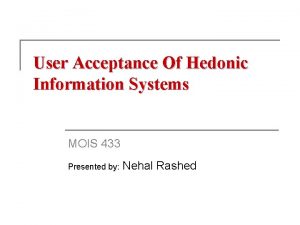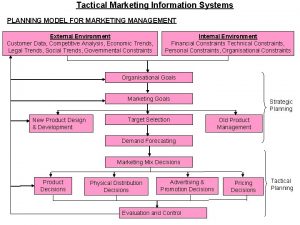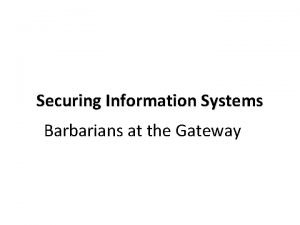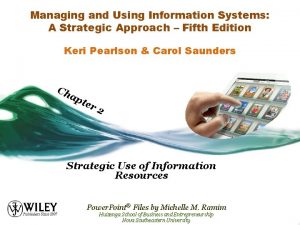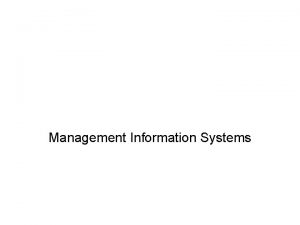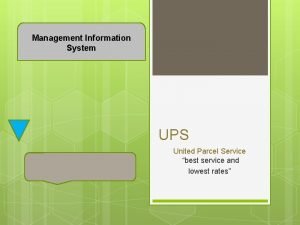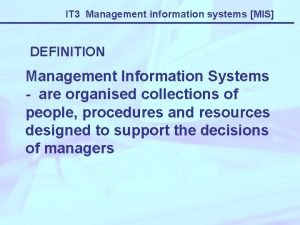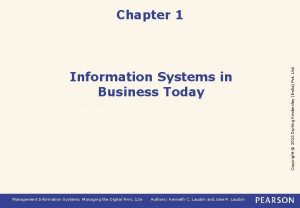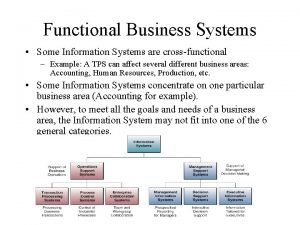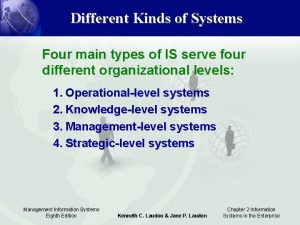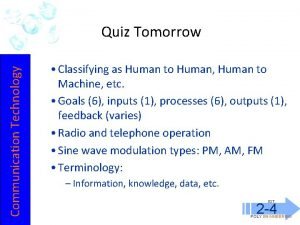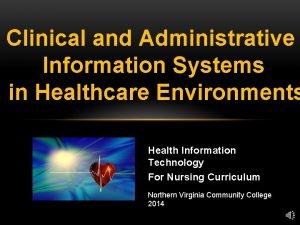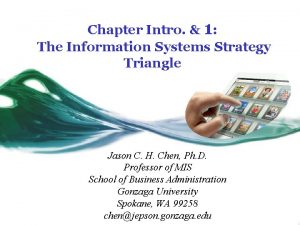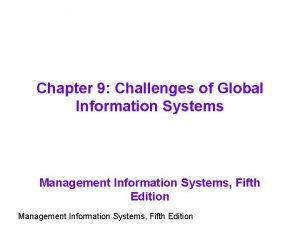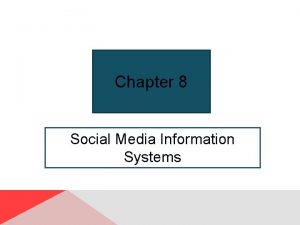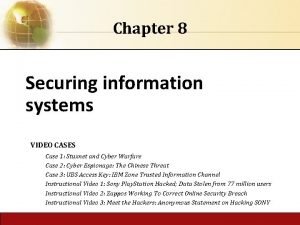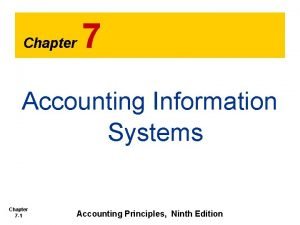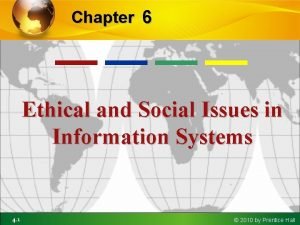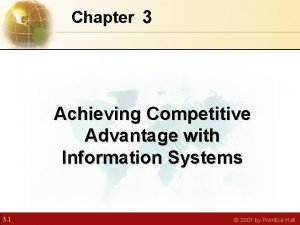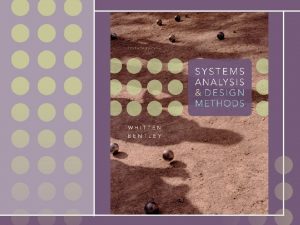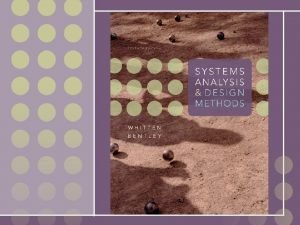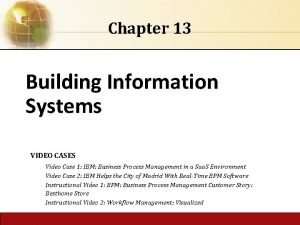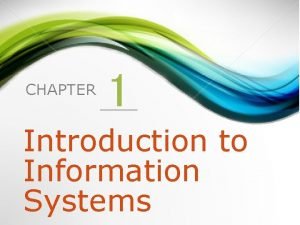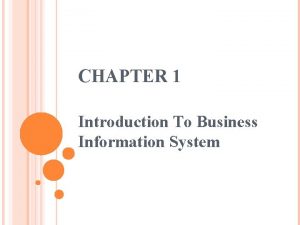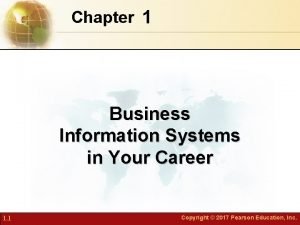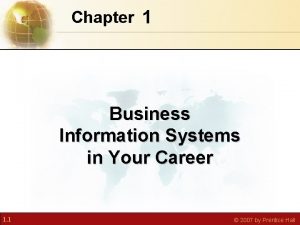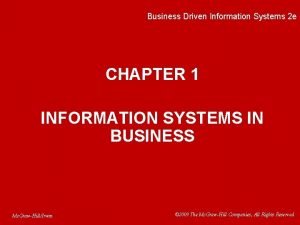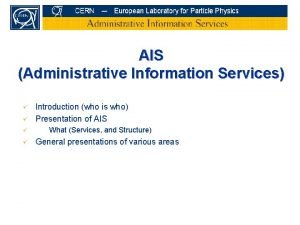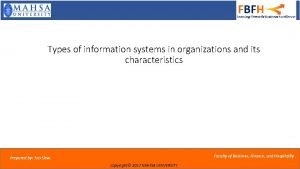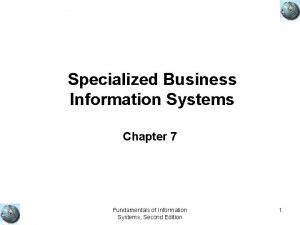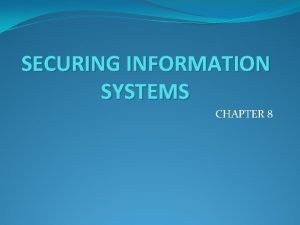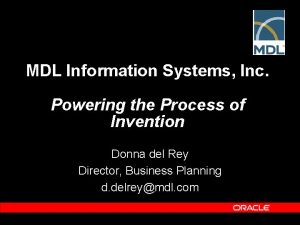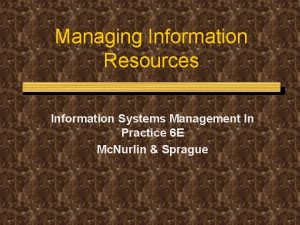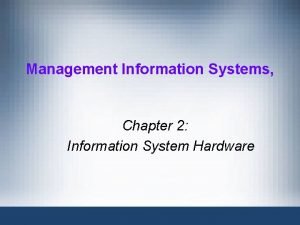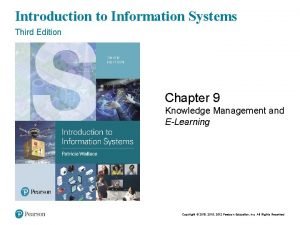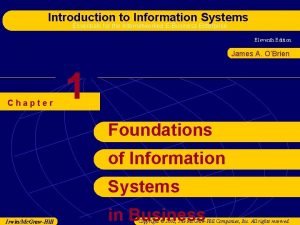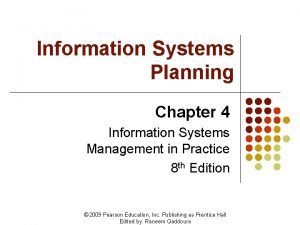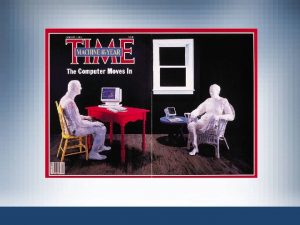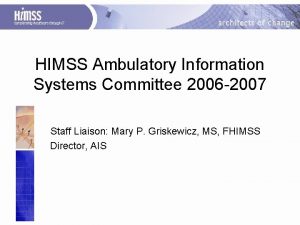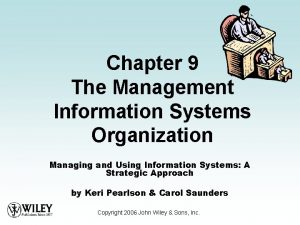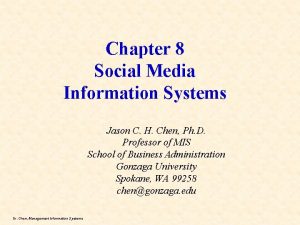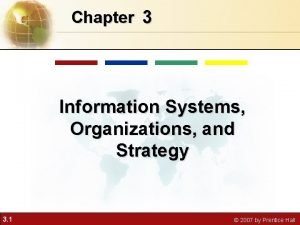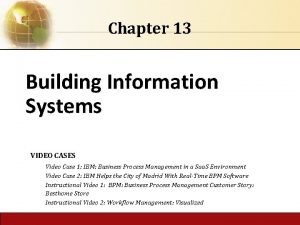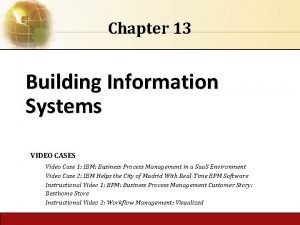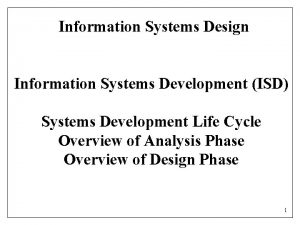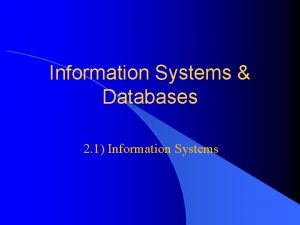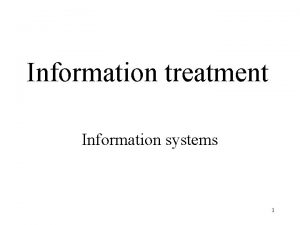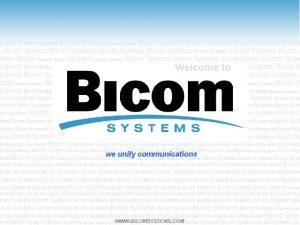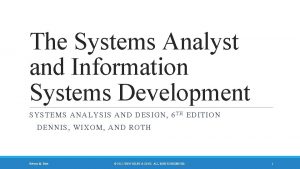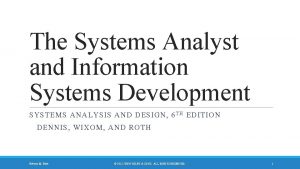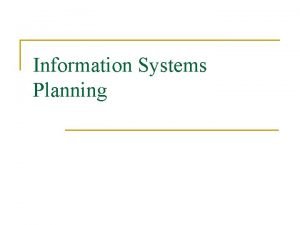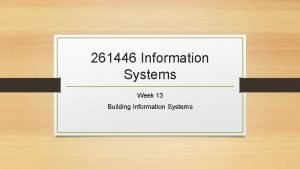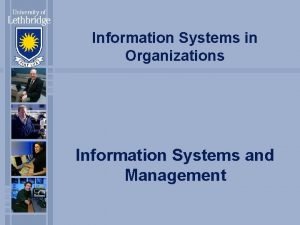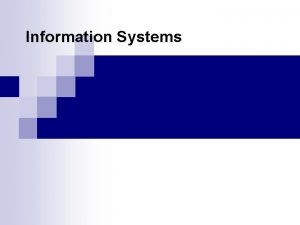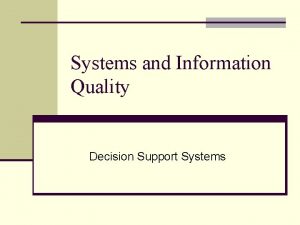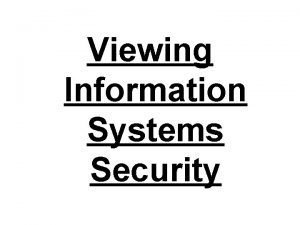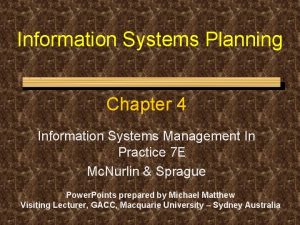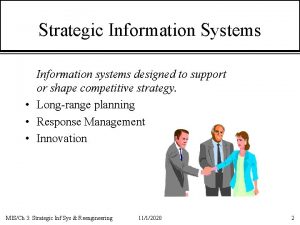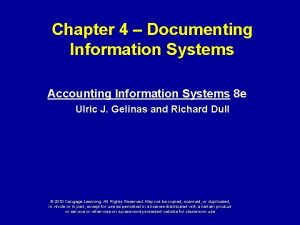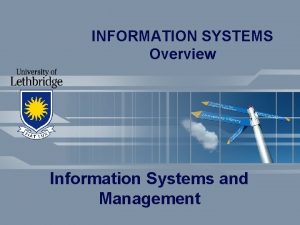Information Systems IS What is Information Systems Information



































































- Slides: 67


Information Systems (IS)


What is Information Systems? • Information systems is an umbrella term for the systems, people and processes designed to create, store, manipulate, distribute and disseminate information. • The field of information systems bridges business and computer science.

• One of the reasons people may not distinguish between IS and IT is that they assume all information systems are computer-based systems. • An information system, however, can be as simple as a pencil and a piece of paper. • Separate, the objects are just tools. Used together, they create a system for recording information.

• Although information systems are heavily reliant on computers and other technologybased tools, the term predates computers and can include non-technological systems. • One example is management information systems, which use information such as a database to improve performance, create reports and make decisions.

List of Computerbased Information System According to: Dasig Jr, Daniel. (2014). A Study on the Sectors of Economy Serviced by Pre-Industry System Developers among Companies in Metro Manila : A Tool for Business Reengineering. International Journal of Business Information Systems Strategies. 3. 10. 14810/ijbiss. 2014. 3301.


Information Technology (IT)


What is Information Technology? • Information Technology (IT) is concerned with the use of technology in managing and processing information • IT typically includes hardware, software, databases and networks. • Information technology often governs the acquisition, processing, storage and dissemination of digitized information, or data, generated through the disciplines of computing and telecommunications.

• Information technology focuses on managing technology and improving its utilization to advance the overall business goals.

Critical Information Technologies According to: Kim, J. S. & Wen, Joseph & Rich, J. . (2009). A scoring method for prioritizing non-mutually-exclusive information technologies. Human Systems Management. 28. 1 -17. 10. 3233/HSM-2009 -0691.


Using Information Systems to Achieve Competitive Advantage – The Internet’s Impact on Competitive Advantage

• Enables new products and services • Encourages substitute products • Lowers barrier to entry • Changes balance of power of customers and suppliers • Transforms some industries • Creates new opportunities for creating new markets, building brands, and large customer bases

Emerging (Newer? ) Technologies

Big Data


Internetlivestats. com statista. com

• It is generally accepted that big data can be explained according to three V’s: Velocity, Variety and Volume. • i. e. increasing volume (amount of data), velocity (speed of data in and out), and variety (range of data types and sources). Later in 2012 Gartner updated the definition of big data as high volume, high velocity, high variety.

• The Velocity is the speed at which the data is created, stored, analysed and visualised. • Every minute we upload 500 hours of videos on Youtube (Statista). In addition, every day over 281 billion emails are sent & received (Statista), around 20 million photos are viewed and 30. 000 uploaded on Flickr, almost 300. 000 tweets are sent, and almost 3. 5 billion queries on Google are performed daily (Internetlivestats).

• The Volume - 90% of all data ever created, was created in the past two years. • From now on, the amount of data in the world will double every two years. • A very large contributor to the ever-expanding digital universe is the Internet of Things with sensors all over the world in all devices creating data every second. • If we look at aeroplanes they generate approximately 2, 5 billion Terabyte of data each year from the sensors installed in the engines.

• Variety - in the past, all data that was created was structured data, it neatly fitted in columns and rows but those days are over. • Nowadays, 90% of the data that is generated by the organisation is unstructured data. Data today comes in many different formats: structured data, semi-structured data, unstructured data and even complex structured data.

• What are the additional Vs?

Enterprise Resource Planning (ERP)

• ERP is usually referred to as a category of business management software — typically a suite of integrated applications—that an organization can use to collect, store, manage, and interpret data from many business activities.



• Compare them (challenges and opportunities of each)

E-governance

• Electronic governance or e-governance is the application of information and communication technology (ICT) for delivering government services, exchange of information, communication transactions, integration of various stand-alone systems and services between government-to-citizen (G 2 C), government-to-business (G 2 B), government-togovernment (G 2 G), government-to-employees (G 2 E) as well as back-office processes and interactions within the entire government framework.

• Through e-governance, government services are made available to citizens in a convenient, efficient, and transparent manner. The three main target groups that can be distinguished in governance concepts are government, citizens, and businesses/interest groups


• What are examples of E-governance services?

Information Overload/ Infobesity

exposure to or provision of too much information or data. "the main challenge for consumers is information overload"

• Information overload (also known as infobesity, infoxication, information anxiety, and information explosion) is the difficulty in understanding an issue and effectively making decisions when one has too much information about that issue. • Generally, the term is associated with the excessive quantity of daily information.

• Information overload occurs when the amount of input to a system exceeds its processing capacity. • Decision makers have fairly limited cognitive processing capacity. Consequently, when information overload occurs, it is likely that a reduction in decision quality will occur.

• In recent years, the term "information overload" has evolved into phrases such as "information glut", "data smog", and "data glut" (Data Smog, Shenk, 1997).

• Is too much Info an Opportunity or a Challenge? Discuss • How to protect yourself from Info Overload? • How to position yourself to too much Info?

Social Networking Sites


• A social networking service (also social networking site or social media) is an online platform which people use to build social networks or social relationship with other people who share similar personal or career interests, activities, backgrounds or real-life connections (Wikipedia, 2019). • Is a definition a challenge?



• Most popular social networks worldwide as of October 2019, ranked by number of active users (in millions) • https: //www. statista. com/statistics/272014/gl obal-social-networks-ranked-by-number-ofusers/

• How Social networking sites can be used in learning and work environment? discuss • How marketing in Social networking sites is done? • What are challenges Social networking sites poses to businesses? • https: //www. investopedia. com/terms/s/social -networking. asp

• What are some issues related to Social networking? (Spamming, Privacy, Risk for child safety, Online bullying, Employability, Potential for misuse, etc. ) • What are the basic features/ must have of a typical Social networking site? • https: //en. wikipedia. org/wiki/Social_networki ng_service

Social Media

• Social media is the media (content) that you upload — whether that’s a blog, video, slideshow, podcast, newsletter or an e. Book. • Consider social media as a one-to-many communication method. Although people can respond and comment, you own the content and have to produce (write/record/create) the media yourself.

• If you consider what you understood media to be before the Internet existed, it was about television, newspapers, magazines, etc.


Moodle. iaa. ac. tz

Search Engines


• A web search engine or Internet search engine is a software system that is designed to carry out web search (Internet search), which means to search the World Wide Web in a systematic way for particular information specified in a textual web search query.

• The search results are generally presented in a line of results, often referred to as search engine results pages (SERPs). • The information may be a mix of links to web pages, images, videos, infographics, articles, research papers, and other types of files.

Market share

Search Engine Submission • The act of supplying a URL to a search engine in an attempt to make a search engine aware of a site or page. • At a minimum, submitting to a search engine involves adding the URL of the site or page that will be under consideration. Search engines sometimes ask for additional contact information, including name and/or email address.

• Policies for adding URLs vary among various search engines. Some search engines only ask for the main URL of a site, claiming that the rest of the site will be spidered; others require the submission of individual pages. Variation also exists with regard to how often URLs may be added, as some engines have tried to discourage bulk submissions in an attempt to minimize spamming.

• Submitting sites/pages can be done manually or in an automated manner. Manual submission involves going to each of the “Add URL” pages and filling out the form fields individually. Automatic submission involves filling out information only one time; the necessary information is then used by a software program to submit to many search engines.

• What are the basic features of Search engines? • How to use search engine? • Differentiate between basic search and advanced search




 Decision support systems and intelligent systems
Decision support systems and intelligent systems Engineering elegant systems: theory of systems engineering
Engineering elegant systems: theory of systems engineering Embedded systems vs cyber physical systems
Embedded systems vs cyber physical systems Elegant systems
Elegant systems User acceptance of hedonic information systems
User acceptance of hedonic information systems Tactical marketing information systems
Tactical marketing information systems Securing information system
Securing information system Retail management upc
Retail management upc Principles of business information systems
Principles of business information systems Managing and using information systems
Managing and using information systems Management information system topics
Management information system topics Management information system chapter 1
Management information system chapter 1 Types of management information system
Types of management information system What technologies are used by ups
What technologies are used by ups Components of mis
Components of mis Objective of a business firm?
Objective of a business firm? Introduction to information systems 6th edition
Introduction to information systems 6th edition Fundamentals of information systems 9th edition
Fundamentals of information systems 9th edition Fundamentals of information systems 9th edition
Fundamentals of information systems 9th edition Functional system in business
Functional system in business Issues in information systems
Issues in information systems Voyage estimating decision support system
Voyage estimating decision support system Communication technology quiz
Communication technology quiz Clinical and administrative health information system
Clinical and administrative health information system Information systems strategy triangle
Information systems strategy triangle Obstacles to using global information systems
Obstacles to using global information systems Social media information system
Social media information system Securing information systems
Securing information systems Securing information systems
Securing information systems Chapter 8 securing information systems
Chapter 8 securing information systems Chapter 7 accounting information systems
Chapter 7 accounting information systems Chapter 7 accounting information systems
Chapter 7 accounting information systems Ethical and social issues in information system
Ethical and social issues in information system Achieving competitive advantage with information systems
Achieving competitive advantage with information systems Information systems building blocks
Information systems building blocks Building blocks of an information system
Building blocks of an information system Collaboration information systems
Collaboration information systems Redesigning the organization with information systems
Redesigning the organization with information systems Dfd ch 13
Dfd ch 13 Informed user of information systems
Informed user of information systems Introduction to business information systems
Introduction to business information systems How will information systems affect business careers
How will information systems affect business careers How will information systems affect business careers
How will information systems affect business careers Business driven information systems
Business driven information systems Fundamentals of information systems chapter 1
Fundamentals of information systems chapter 1 Administrative information systems ais
Administrative information systems ais Types of information systems in an organization
Types of information systems in an organization Specialized information systems examples
Specialized information systems examples An information systems examines a firm's overall security
An information systems examines a firm's overall security Fundamental of information system
Fundamental of information system Mdl information systems
Mdl information systems Analytical marketing system
Analytical marketing system Information systems management in practice
Information systems management in practice Vertical
Vertical What is information system hardware
What is information system hardware Introduction to information systems 3rd edition
Introduction to information systems 3rd edition Introduction to management information systems 5th edition
Introduction to management information systems 5th edition Essentials of information systems
Essentials of information systems Information systems planning
Information systems planning Knowledge management and specialized information systems
Knowledge management and specialized information systems How do information systems aid in decision making
How do information systems aid in decision making Ambulatory information systems
Ambulatory information systems Egton medical information systems
Egton medical information systems Management information systems wiley
Management information systems wiley Social media information systems
Social media information systems Information systems organizations and strategy
Information systems organizations and strategy The oldest method for building information systems is
The oldest method for building information systems is The oldest method for building information systems is:
The oldest method for building information systems is:




